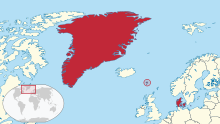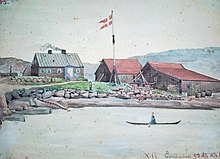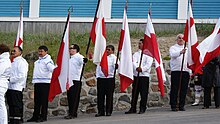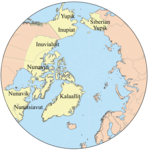
Greenland is a North American autonomous territory of the Kingdom of Denmark. It is the largest country within the Kingdom and one of three countries which form the Kingdom, the others being Denmark proper and the Faroe Islands; the citizens of all three countries are citizens of Denmark. As Greenland is one of the Overseas Countries and Territories of the European Union, citizens of Greenland are also granted European Union citizenship. The capital and largest city of Greenland is Nuuk. Greenland lies between the Arctic and Atlantic oceans, east of the Canadian Arctic Archipelago. It is the world's largest island, as well as the northernmost area of the world – Kaffeklubben Island off the northern coast is the world's northernmost undisputed point of land, and Cape Morris Jesup on the mainland was thought to be so until the 1960s.

This is a demography of the population of Greenland including population density, ethnicity, economic status, religious affiliations and other aspects of the population.

The history of Greenland is a history of life under extreme Arctic conditions: currently, an ice sheet covers about eighty percent of the island, restricting human activity largely to the coasts.

Nuuk is the capital of and most populous city in Greenland, an autonomous territory in the Kingdom of Denmark. Nuuk is the seat of government and the territory's largest cultural and economic center. The major cities from other countries closest to the capital are Iqaluit and St. John's in Canada and Reykjavík in Iceland. Nuuk contains a third of Greenland's population and its tallest building. Nuuk is also the seat of government for the Sermersooq municipality. In January 2023, it had a population of 19,604. Nuuk is considered a modernized city after the policy began in 1950.
The culture of Greenland has much in common with Greenlandic Inuit tradition, as the majority of people are descended from Inuit. Many people still go ice fishing and there are annual dog-sled races in which everyone with a team participates.

The Danish Realm, officially the Kingdom of Denmark, is the area over which the monarch of Denmark is head of state. It consists of metropolitan Denmark—the kingdom's territory in continental Europe and sometimes called "Denmark proper" —and the realm's two autonomous regions: the Faroe Islands in North Atlantic and Greenland in North America. The relationship between the three parts of the Kingdom is also known as The unity of the Realm.

The Greenlandic Inuit are the indigenous and most populous ethnic group in Greenland. Most speak Greenlandic and consider themselves ethnically Greenlandic. People of Greenland are citizens of Denmark.
Maliina Abelsen was the General Manager for Arctic Winter Games 2016 and is a former Greenlandic politician and MP for the party Inuit Ataqatigiit (IA), holding the position of the Minister for Finance in the Government of Greenland, in office from 2011-2013. Between June 2009 and March 2011, Abelsen held the position of the Minister for Social Affairs in the Government of Greenland. Since 2020, Abelsen has been programme manager for UNICEF Denmark in Greenland.

Eksperimentet is a 2010 Danish drama film written and directed by Louise Friedberg, and starring Ellen Hillingsø. The film premiered on 28 August 2010 in the Katuaq Culture Centre in Nuuk, the capital of Greenland. The release date of the film in Denmark was 9 September 2010.

Greenlandic independence is a political ambition of some political parties, advocacy groups, and individuals of Greenland, an autonomous territory within the Kingdom of Denmark, to become an independent sovereign state.
Danish Greenlanders are ethnic Danes residing in Greenland and their descendants.

After being a part of the European Communities (EC) for twelve years, Greenland withdrew in 1985. It had joined the EC in 1973 as a county of Denmark, even though a majority in Greenland was against joining. In a consultative referendum in 1982, 53% of the electorate of Greenland voted to withdraw from the Communities. This latter referendum became possible after the introduction of home rule in Greenland in 1979. Following its withdrawal, which was regulated through the Greenland Treaty, the relationship between Greenland and the EC was partly settled through an association under Overseas Countries and territories (OCT) status. In recent years, the Greenlandic withdrawal from the European Communities has marginally been referred to as "Greenxit".

Mâliâraq Vebæk was a Greenlandic teacher and writer. She is known as the first woman of Greenland to publish a novel. One of the first women to obtain a higher education in Greenland, she began her career as a teacher. After six years, she relocated to Denmark and worked on archaeological excavations and ethnographic surveys with her husband from 1946 to 1962. She began publishing stories, legends and folktales in the 1950s, both through print media and on radio. In 1981, after having participated in a survey on the intercultural issues for Greenlanders and Danes, published a novel inspired by the research. It won the Greenlandic Authors Association Award for 1982.

Human rights in the Kingdom of Denmark are protected by the state's Constitution of the Realm (Danmarks Riges Grundlov); applying equally in Denmark proper, Greenland and the Faroe Islands, and through the ratification of international human rights treaties. Denmark has held a significant role in the adoption of both the European Convention on Human Rights and in the establishment of the European Court of Human Rights (ECHR). In 1987, the Kingdom Parliament (Folketinget) established a national human rights institution, the Danish Centre of Human Rights, now the Danish Institute for Human Rights.

Henriette Ellen Kathrine Vilhelmine Rasmussen née Jeremiassen was a Greenlandic educator, journalist, women's rights activist and politician. In 1992, she provided support for the adoption of the UN Convention on the Rights of the Child and in 1996, was appointed principal advisor to the ILO in connection with the 1989 Indigenous and Tribal Peoples Convention. As a member of Inuit Ataqatigiit from the early 1980s, she strove for Greenlandic independence from Denmark and served as Greenland's Minister of Culture and Education (2003–2005).
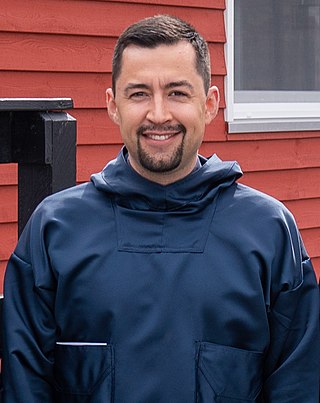
Múte Inequnaaluk Bourup Egede is a Greenlandic politician currently serving as the seventh prime minister of Greenland, a position he has held since April 2021. He has served as a member of the Inatsisartut, the parliament of Greenland, since 2015, and furthermore as chairman of the Inuit Ataqatigiit party since 2018.

Pele Broberg is a Greenlandic politician (Naleraq), entrepreneur and pilot. He became minister of foreign affairs, trade, climate and business in April 2021, but foreign affairs and climate were transferred to the premier of Greenland Múte Bourup Egede in September 2021 after a controversy. Broberg was minister for finance in 2018.
The little Danes experiment, also known simply as the experiment, was a 1951 Danish operation where 22 Greenlandic Inuit children were sent to Danish foster families in an attempt to re-educate them as "little Danes". While the children were all supposed to be orphans, most were not. Six children were adopted while in Denmark, and sixteen returned to Greenland, only to be placed in Danish-speaking orphanages and never live with their families again. Half of the children experienced mental health disturbances, and half of them died in young adulthood. The government of Denmark officially apologised in 2020, after several years of demands from Greenlandic officials.
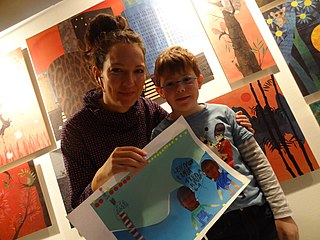
Bolatta Silis-Høegh is a Greenlandic contemporary artist and children's book author and illustrator who lives in Denmark.
The spiral case is an ongoing investigation into a birth control campaign by Danish government in Greenland, primarily during the 1960s and 1970s. Often without consent and under the direction of Danish government officials, Danish doctors placed intrauterine devices in thousands of Greenlandic Inuit girls and women. The program was created to control Greenland's birth rate.
